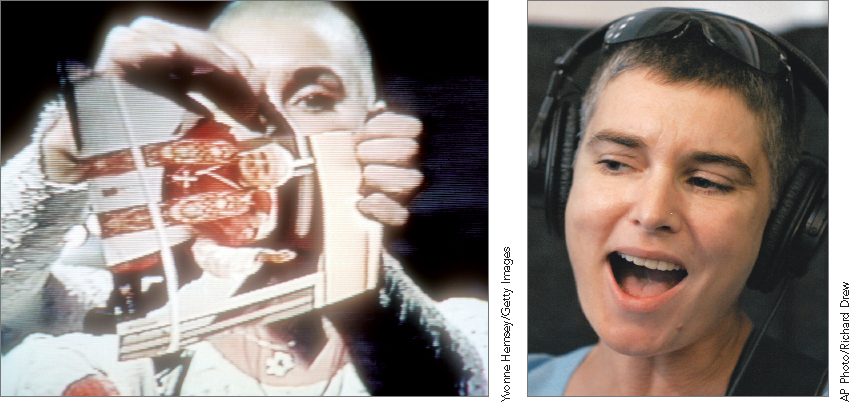8.2 Treatments for Bipolar Disorders
Until the latter part of the twentieth century, people with bipolar disorders were destined to spend their lives on an emotional roller coaster. Psychotherapists reported almost no success, and antidepressant drugs were of limited help. In fact, the drugs sometimes triggered a manic episode (Courtet, Samalin, & Olié, 2011; Post, 2011, 2005). And ECT only occasionally relieved either the depressive or the manic episodes of bipolar disorders.

This gloomy picture changed dramatically in 1970 when the FDA approved the use of lithium, a silvery-
 lithium A metallic element that occurs in nature as a mineral salt and is an effective treatment for bipolar disorders.
lithium A metallic element that occurs in nature as a mineral salt and is an effective treatment for bipolar disorders.
 mood stabilizing drugs Psychotropic drugs that help stabilize the moods of people suffering from bipolar disorder. Also known as antibipolar drugs.
mood stabilizing drugs Psychotropic drugs that help stabilize the moods of people suffering from bipolar disorder. Also known as antibipolar drugs.
Nevertheless, it was lithium that first brought hope to those suffering from bipolar disorder. Recall the praise for lithium offered by psychiatric researcher Kay Redfield Jamison at the beginning of this chapter. Here Jamison describes in more detail her relationship with the drug and the role it has played in her recovery from bipolar disorder:
My war with lithium began not long after I started taking it. I was first prescribed lithium in the fall of 1974; by the early spring of 1975, against medical advice, I had stopped taking it. Once my initial mania had cleared and I had recovered from the terrible depression that followed in its wake, an army of reasons had gathered in my mind to form a strong line of resistance to taking medication. Some of the reasons were psychological in nature. Others were related to the side effects that I experienced from the high blood levels of lithium that were required, at least initially, to keep my illness in check. (In 1974 the standard medical practice was to maintain patients at considerably higher blood levels of lithium than is now the case. I have been taking a lower dose of lithium for many years, and virtually all of the problems I experienced earlier in the course of my treatment have disappeared.) …
[In addition], I simply did not want to believe that I needed to take medication. I had become addicted to my high moods; I had become dependent upon their intensity, euphoria, assuredness, and their infectious ability to induce high moods and enthusiasms in other people. Like gamblers who sacrifice everything for the fleeting but ecstatic moments of winning, or cocaine addicts who risk their families, careers, and lives for brief interludes of high energy and mood, I found my milder manic states powerfully inebriating and very conducive to productivity. I couldn’t give them up….
It was not that I ever thought lithium was an ineffective drug. Far from it. The evidence for its efficacy and safety was compelling. Not only that, I knew it worked for me. It certainly was not that I had any moral arguments against psychiatric medications. On the contrary … I believe, without doubt, that manic-
Unfortunately, this resistance to taking lithium is played out in the lives of tens of thousands of patients every year. Almost always it leads to a recurrence of the illness; not uncommonly it results in tragedy….
At this point in my existence, I cannot imagine leading a normal life without both taking lithium and having had the benefits of psychotherapy. Lithium prevents my seductive but disastrous highs, diminishes my depressions, clears out the wool and webbing from my disordered thinking, slows me down, gentles me out, keeps me from ruining my career and relationships, keeps me out of a hospital, alive, and makes psychotherapy possible. [At the same time], ineffably, psychotherapy heals. It makes some sense of the confusion, reins in the terrifying thoughts and feelings, returns some control and hope and possibility of learning from it all. Pills cannot, do not, ease one back into reality; they only bring one back headlong, careening, and faster than can be endured at times. Psychotherapy is a sanctuary; it is a battleground; … it is where I have believed—
(Jamison, 1995, pp. 92–
Lithium and Other Mood Stabilizers
The discovery that lithium effectively reduces bipolar symptoms was, like so many other medical discoveries, quite accidental. In 1949 an Australian psychiatrist, John Cade, hypothesized that manic behavior is caused by a toxic level of uric acid in the body. He set out to test this theory by injecting guinea pigs with uric acid, but first he combined it with lithium to increase its solubility.
To Cade’s surprise, the guinea pigs became not manic but quite lethargic after their injections. Cade suspected that the lithium had produced this effect. When he later administered lithium to 10 human beings who had mania, he discovered that it calmed and normalized their mood. Many countries began using lithium for bipolar disorders soon after, but as noted earlier, it was not until 1970 that the FDA approved it.
Determining the correct lithium dosage for a given patient is a delicate process requiring regular analyses of blood and urine samples and other laboratory tests. Too low a dose will have little or no effect on the bipolar mood swings, but too high a dose can result in lithium intoxication (literally, poisoning), which can cause nausea, vomiting, sluggishness, tremors, dizziness, slurred speech, seizures, kidney dysfunction, and even death. With the correct dose, however, lithium often produces a noticeable change (Geddes & Miklowitz, 2013; Grof, 2010). Some patients respond better to the other mood stabilizing drugs, such as the antiseizure drugs carbamazepine (Tegretol) or valproate (Depakote), or to a combination of such drugs (Selle et al., 2014; Altamura et al., 2011). And still others respond best to a combination of mood stabilizers and atypical antipsychotic drugs, medications that you will read about in Chapter 15 (Selle et al., 2014; Nivoli et al., 2011).
Given the effectiveness of lithium and other mood stabilizers, around one-

Effectiveness of Lithium and Other Mood StabilizersAll manner of research has attested to the effectiveness of lithium and other mood stabilizers in treating manic episodes (Geddes & Miklowitz, 2013; Grof, 2010, 2005). More than 60 percent of patients with mania improve on these medications. In addition, most such patients have fewer new episodes as long as they continue taking the medications (Malhi et al., 2013; Gao et al., 2010). One study found that the risk of relapse is 28 times higher if patients stop taking a mood stabilizer (Suppes et al., 1991). These findings suggest that the mood stabilizers are also prophylactic drugs, ones that actually help prevent symptoms from developing. Thus, today’s clinicians usually continue patients on some level of a mood stabilizing drug even after their manic episodes subside (Gao et al., 2010).
In the limited body of research that has been done on this subject, the mood stabilizers also seem to help those with bipolar disorder overcome their depressive episodes, though to a lesser degree than they help with their manic episodes (Malhi et al., 2013; Post, 2011). In addition, continued doses of mood stabilizers may help reduce the risk of future depressive episodes and future suicide attempts, just as they seem to prevent the return of manic episodes (Gao et al., 2010; Carney & Goodwin, 2005). Given the drugs’ less powerful impact on depressive episodes, many clinicians use a combination of mood stabilizers and antidepressant drugs to treat bipolar depression, although research suggests that antidepressants may trigger manic episodes in some cases (Nivoli et al., 2011; Post, 2011; Vazquez et al., 2011).
Mode of Operation of Mood StabilizersResearchers do not fully understand how mood stabilizing drugs operate (Malhi et al., 2013; Aiken, 2010). They suspect that the drugs change synaptic activity in neurons, but in a way different from that of antidepressant drugs. The firing of a neuron actually consists of several phases that ensue at lightning speed. When the neurotransmitter binds to a receptor on the receiving neuron, a series of changes occur within the receiving neuron to set the stage for firing. The substances in the neuron that carry out those changes are often called second messengers because they relay the original message from the receptor site to the firing mechanism of the neuron. (The neurotransmitter itself is considered the first messenger.) Whereas antidepressant drugs affect a neuron’s initial reception of neurotransmitters, mood stabilizers appear to affect a neuron’s second messengers (Gawryluk & Young, 2011).
 second messengers Chemical changes within a neuron just after the neuron receives a neurotransmitter message and just before it responds.
second messengers Chemical changes within a neuron just after the neuron receives a neurotransmitter message and just before it responds.

BETWEEN THE LINES
Race and Noncompliance
A study of bipolar outpatients found that half of the African American patients and half of the white American patients failed to take their antibipolar medications as prescribed (Fleck et al., 2005). Why? Patients of both races were equally likely to point to the medications’ undesired effects. However, the African American patients were more likely than the white American patients to further cite a fear of becoming addicted to the drugs and a concern that the drugs symbolized severe illness.
Different second-
In a similar vein, it has been found that lithium and other mood stabilizing drugs also increase the production of neuroprotective proteins—key proteins within certain neurons whose job is to prevent cell death. The drugs may increase the health and functioning of those cells and thus reduce bipolar symptoms (Malhi et al., 2013; Gray et al., 2003).
Alternatively, it may be that the mood stabilizers correct bipolar functioning by directly changing sodium and potassium ion activity in neurons (Swonger & Constantine, 1983). In Chapter 7 you read that bipolar disorders may be triggered by unstable alignments of ions along the membranes of certain neurons in the brain. If this instability is the key to bipolar problems, mood stabilizers would be expected to have some kind of effect on the ion activity. Several studies in fact suggest that lithium ions often substitute, although imperfectly, for sodium ions, and other research suggests that lithium changes the transport mechanisms that move ions back and forth across the neural membrane (Lambert & Kinsley, 2010; Soares et al., 1999; Baer et al., 1971).
Adjunctive Psychotherapy
Psychotherapy alone is rarely helpful for persons with bipolar disorders. At the same time, clinicians have learned that mood stabilizing drugs alone are not always sufficient either. Thirty percent or more of patients with these disorders may not respond to lithium or a related drug, may not receive the proper dose, or may relapse while taking it. In addition, a number of patients stop taking mood stabilizers on their own because they are bothered by the drugs’ unwanted effects, feel too well to recognize the need for the drugs, miss the euphoria felt during manic episodes, or worry about becoming less productive when they take the drugs (Advokat et al., 2014; Aiken, 2010).
BETWEEN THE LINES
In Their Words
“Start every day off with a smile; get it over with.”
(W.C. Fields, 1879–
In view of these problems, many clinicians now use individual, group, or family therapy as an adjunct to mood stabilizing drugs (Reinares et al., 2014; Geddes & Miklowitz, 2013; Lee et al., 2011). Most often, therapists use these formats to emphasize the importance of continuing to take medications; to improve social skills and relationships that may be affected by bipolar episodes; to educate patients and families about bipolar disorders; to help patients solve the family, school, and occupational problems caused by their disorder; and to help prevent patients from attempting suicide (Hollon & Ponniah, 2010). Few controlled studies have tested the effectiveness of such adjunctive therapy, but those that have been done, along with numerous clinical reports, suggest that it helps reduce hospitalization, improves social functioning, and increases patients’ ability to obtain and hold a job (Culver & Pratchett, 2010). Psychotherapy plays a more central role in the treatment of cyclothymic disorder, the mild bipolar pattern that you read about in Chapter 7. In fact, patients with cyclothymic disorder typically receive psychotherapy, alone or in combination with mood stabilizers.